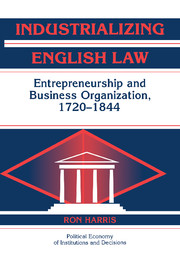Book contents
- Frontmatter
- Contents
- List of Tables
- Acknowledgements
- Introduction
- 1 The Legal Framework
- PART I BEFORE 1720
- 2 The Pre-1720 Business Corporation
- 3 The Bubble Act, Its Passage, and Its Effects
- PART II 1721–1810
- PART III 1800–1844
- Conclusion
- Appendix 1 The Rise and Decline of the Major Trading Corporations
- Appendix 2: Capital of Joint-Stock Companies Circa 1810
- Bibliography
- Index of Cases
- Index of Statutes
- General Index
2 - The Pre-1720 Business Corporation
Published online by Cambridge University Press: 12 August 2009
- Frontmatter
- Contents
- List of Tables
- Acknowledgements
- Introduction
- 1 The Legal Framework
- PART I BEFORE 1720
- 2 The Pre-1720 Business Corporation
- 3 The Bubble Act, Its Passage, and Its Effects
- PART II 1721–1810
- PART III 1800–1844
- Conclusion
- Appendix 1 The Rise and Decline of the Major Trading Corporations
- Appendix 2: Capital of Joint-Stock Companies Circa 1810
- Bibliography
- Index of Cases
- Index of Statutes
- General Index
Summary
In the second half of the sixteenth century and during the seventeenth century, the corporation, a familiar legal conception, increasingly began to be used for a new purpose. Employed since medieval times for ecclesiastical, municipal, educational, and other public or semipublic purposes, the corporation or, as it was often called at that time, the body corporate or body politic, was increasingly used for profit-oriented organization of business. There had been other, earlier, business associations such as guilds, but these had considerable social elements, and served as fellowships or brotherhoods which controlled and ritualized whole aspects of their members' lives. Prior to the sixteenth century, a number of groups of merchants such as the Merchants of the Staple and the early Merchant Adventurers traded with nearby continental ports, but these were associations of individuals usually with no formal legal basis, neither incorporation nor even a royal franchising charter. The novelty of the sixteenth-century corporation lay in the combination of specific business purposes with a formal corporate form of organization, and the fact that many of these new corporations reached beyond Western Europe. This new utilization, in kind and in degree, of the corporation for profit maximizing resulted in no immediate change in its legal conception nor in the features which characterized it. To what degree did the conception and features adapt to the new use by 1720, the starting point of this book? Did the pre-1720 history of the business corporation have any relevance to its post-1720 development?
- Type
- Chapter
- Information
- Industrializing English LawEntrepreneurship and Business Organization, 1720–1844, pp. 39 - 59Publisher: Cambridge University PressPrint publication year: 2000



